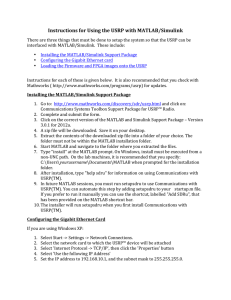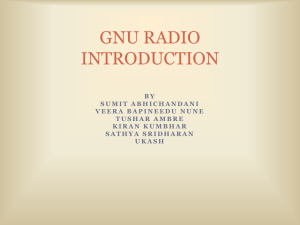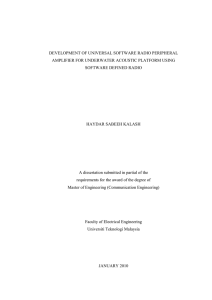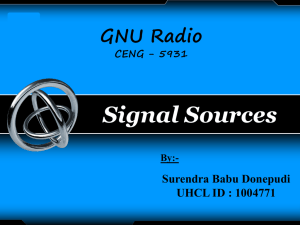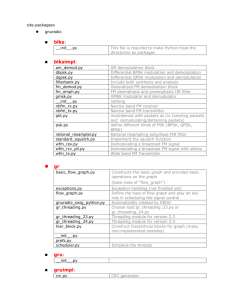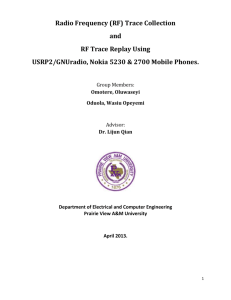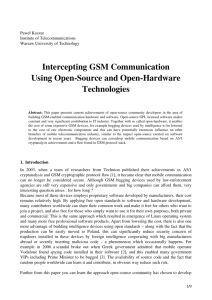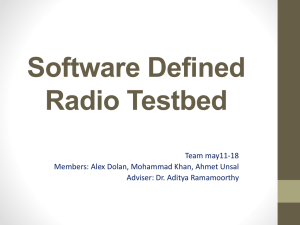USRP2 Presentation
advertisement
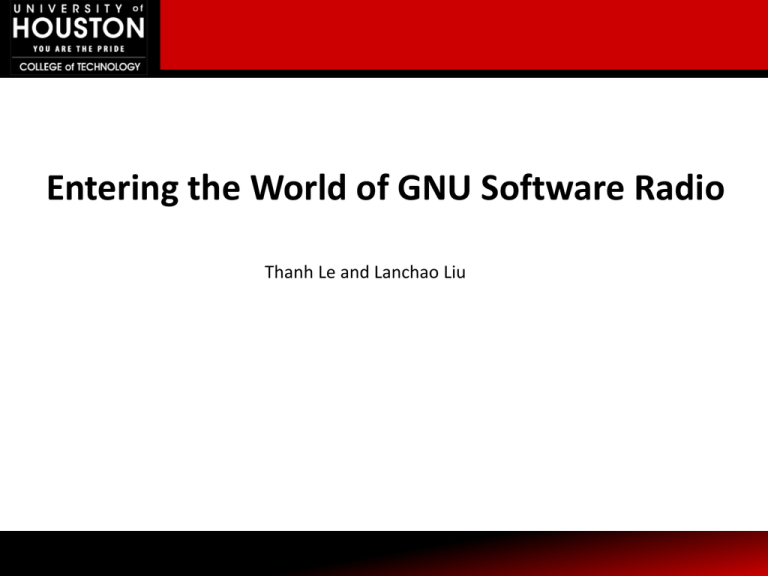
Entering the World of GNU Software Radio Thanh Le and Lanchao Liu Outline • • • • • Introduction Hardware Software GNU Companion Communication Demos PART I - Introduction Software Defined Radio RF/IF conversion circuit FPGA User App http://www.da.isy.liu.se/research/bp/ USRP: Universal Radio Peripheral The hardware solution for GNU SDR USRP USRP2 PART II – Hardware Universal Software Radio Peripheral (USRP) • • • • • 4 ADC 64MS/s (12-bit) 4 DAC 128MS/s (14-bit) USB 2.0 interface¹ Small FPGA² MIMO capable 1. Highest speed 480Mb/s 2. Capable of processing signals up to 16 MHz wide Universal Software Radio Peripheral (USRP2) ¹ • • • • • • 2 ADC 100MS/s (14-bit) 2 DAC 400MS/s (16-bit) Gigabit Ethernet Interface Larger FPGA² On-board SRAM MIMO capable 1. 2 Gbps high-speed serial interface for expansion 2. Capable of processing signals up to 100 MHz wide Available daughter-boards Basic TX/RX: LFTX/LFRX: TVRX: DBSRX: WBX0510: XCVR2450: 1MHz – 250MHz RFX400: 400MHz – 500MHz (20dBm) DC – 30MHz RFX900: 750MHz – 1050MHz(23dBm) 50MHz-860Mhz RFX1200: 1150MHz – 1450MHz(23dBm) 800MHz – 2.4GHz RFX1800: 1.5GHz – 2.1GHz(20dBm) 50MHz – 1GHz(20dBm) RFX2400: 2.3GHz – 2.9GHz(17dBm) 2.4GHz – 2.5GHz & 4.9GHz -5.9GHz(20dBm) • Software Defined Radio Block Diagram • RF Front End Mixer Antenna Low Noise Amplifier Low Pass Filter Low Pass Filter Local Oscillator ADC • FPGA – MUX • FPGA – DDC • Example 2-1: Simple transmission A simple sinusoidal wave is transmitted. We can view it at the receiver in spectrum domain. PART III – Software • GNU radio ― GNU radio is an open source, Python-based architecture for building SDR projects ― C++ written signal processing blocks and python written connectors ― Available on Linux, Mac OS and Windows Signal Generator Python APP2 APP1 FFT Filter Modulation C++ • A thumb of rule For any application, what you need to do at Python level is nothing but drawing a diagram to show the signal flow form the source to the sink using the Python, sometimes with the graphical user interface(GUI) support • GNU Radio Installation Step-by-step instruction available on http://gnuradio.org/redmine/projects/gnuradio/wiki/GettingStarted Install the pre-requisites Get the GNU Radio source code Configure, compile and install GNU Radio All the following demos are built in: Ubuntu-10.10 + gnuradio-3.32 Example 3-1: FFT Src0 (440Hz) Adder Oscilloscope Src1 (640Hz) Data Type • Signal blocks communicate with each other via data stream • GNU Radio requires that input and output data types match exactly Byte – 1 byte of data(8-bit) Short – 2 bytes integer Int – 4 bytes integer Float – 4 bytes floating integer Complex – 8 bytes(a pair of floats) • Tips: the name of the signal block indicates the input/output data type _f : input/output a float _fc: input a float and output a complex _vff: input and output a vector of floats _b: input/output a byte _i: input/output a integer _s: input/output for short • USRP Source/Sink Initialize variable represents the signal block u = usrp2.source_32fc(options.interface, options.mac_addr) u = usrp2.sink_32fc(options.interface, options.mac_addr) For the USRP source: self.connect(u, other_block) For the USRP sink: self.connect(other_block,u) Receive: USRP Source Transmit: USRP Sink Create the USRP source Set the decimation /Interpolation rate Set the gain Set the center frequency Connect to another block Some useful blocks FFT File Sinusoidal Noise Null Vector File Audio USRPn Source Adding a constant Adder Subtracter Multiplying a constant Multiplier Divier Log Simple operators Type Conversion Vector Audio USRPn Sink Low pass/High pass/Band pass/Hilbert/Rais ed Cosine Filters • Example 3-2: Codes reading - FM Receiver Explain the codes for FM receiver line by line. • Useful tools ‘Spectrum analyzer’: usrp2_fft.py ‘Signal generator’: usrp2_siggen_gui.py & usrp2_siggen.py ‘Recorder’: usrp2_rx_cfile.py Offline analyzer: gr_plot_fft.py & gr_plot_psd.py Example 3-3 : ‘Spectrum analyzer’ Example 3-4 : ‘Signal generator’ Example 3-5 : ‘Recorder’ PART IV GRC • GNU Radio Companion A graphical tool that Create signal flow graphs & Generate flow-graph source code Adding proper blocks to the diagram and setting it parameters Connect proper blocks with each other, saving the file. Generating the flow graph, the system will save your design with a .grc file. Executing the flow graph and receive the signal by using USRP2 receiver that we designed before. • Example 4-1: View signal in time/spectrum domain • Example 4-2: View the constellation diagram of a signal PART IV Communication Demos • FM Transmitter gr.wavefile_source() gr.multiply_const_cc() Usrp2.sink_32fc() gr.multiply_const_cc() • AM transmitter Source Gr.interp_fir_filter_fff() Usrp2.sink_32fc gr.multiply_const_ff am_mod=gr.float_to_complex() • Benchmark_tx.py source usrp_transmit_path self.packet_transmitter Modulator USRP Self.amp • Benchmark_rx.py source usrp_receive_path file Low_pass_filter Self.packet_reveiver source • Connection • Spectrum sensing source window fft threshold log10 c2mag • Reference http://www.snowymtn.ca/gnuradio/gnuradiodoc-1.pdf (Totally ten parts, just change the number to get it) http://gnuradio.org/redmine/projects/gnuradio/wiki Thanks to Ruolin Zhou @ Wright State University Questions/Comments
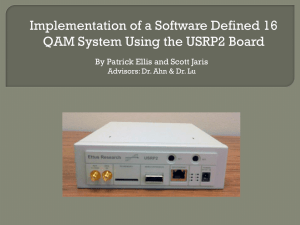
![Chapter 3 Overview and Basics of software Defined Radios[1]](http://s2.studylib.net/store/data/005704797_1-e5ea591c4f19f0cf490d196d110ed37b-300x300.png)
